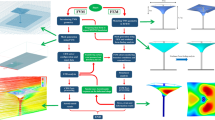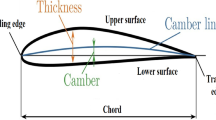Abstract
The wind energy is observed as an essential and powerful energy resource for the socio-economic development. It is proposed that the small-size wind turbines can demonstrate the innovative solution for the wind energy conversion for low speed regions. An innovative design, control, and monitoring processes require accurate and validated dynamic model of such turbines. In this investigation, the flexible multibody dynamics approach is used to extend the traditional method of dynamic modeling of small-size wind turbines. A systematic approach is developed based on floating frame of reference formulation (FFR) that includes the dynamics of the flexible blades as well as the aerodynamic loads. Beam element is used to model the blade structure with variable twist angle. In order to counteract the effect of the geometric stiffening, which comes due to high speed rotations, the coupling terms in the expression of axial strain energy are taken into account. In the other hand, the circulation theory is used to calculate the pressure coefficient difference along the blade, and the generalized aerodynamic forces are established. An experimental test-rig equipped with wind generator is used for the FFR model validation. The equipment gives a maximum discharge flow of 10 (m/s) in a 500 (mm) diameter duct. The dynamic effect of the twist angle of 30 (cm) diameter of rotor blades is studied based on the measured rotor speed of the wind turbine. The comparison of experimental results and numerical solution shows a very good agreement and consequently the wind turbine model obtained is suitable for stress analysis, structural and control design. It is concluded that the FFR formulation is best suited for large rotation and small deformation problems, which coincide with the operational conditions of small-size wind energy systems.














Similar content being viewed by others
References
Kalle\(\phi \)e BS (2007) Aeroservoelasticity of wind turbines. PhD thesis, Dept. of mechanical engineering, Technical University of Denmark
Karthikeyan N, Murugavel KK, Kumar SA, Rajakumar S (2015) Review of aerodynamic developments on small horizontal axis wind turbine blade. Renew Sustain Energy Rev 42(2015):801–822
Nada AA, Hussein BA, Megahed SM, Shabana AA (2009) Floating frame of reference and absolute nodal coordinate formulations in the large deformation analysis of robotic manipulators: a comparative experimental and numerical study. ASME(IDETC/CIE 2009), San Diego
Nada AA, Hussein BA, Megahed SM, Shabana AA (2010) Use of the floating frame of reference formulation in large deformation analysis: experimental and numerical validation. Proc Inst Mech Eng K J Multi-body Dyn 224:45–58
Nada A, El-Assal A (2012) Absolute nodal coordinate formulation of large-deformation piezoelectric laminated plates. Nonlinear Dyn Nonlinear Dyn 67(4):2241–2454
Nada AA (2013) Use of B-spline surface to model large-deformation continuum plates: procedure and applications. Nonlinear Dyn 72:243–263
Bayoumy AH, Nada AA, Megahed SM (2013) A continuum based three-dimensional modeling of wind turbine blades. Comput Non Dyn 8(3):031004
Bayoumy AH, Nada AA, Megahed SM (2012) Modeling slope discontinuity of large size wind-turbine blade using absolute nodal coordinate formulation. ASME(IDETC/CIE 2012), Chicago
Nada AA (2014) Efficient modeling of continuum blades using ANCF curved shell element. In: 5th European conference on computational mechanics (ECCM V), Barcelona, Spain, pp 3092-3103, 20–25 July 2014
Sugiyama H, Escalona J, Shabana AA (2003) Formulation of three-dimensional joint constraints using the absolute nodal coordinates. Nonlinear Dyn 31(2):167–195
Korkealaakso P, Mikkola A, Rantalainen T, Rouvinen A (2009) Description of joint constraints in the floating frame of reference formulation. Proc Inst Mech Eng K J Multi-body Dyn 223:133–145
Shabana AA (2010) Computational continuum mechanics. Cambridge University Press, Cambridge
Shabana AA (2005) Dynamics of multibody systems, 3rd edn. Cambridge University Press, Cambridge
Shabana AA (2010) Computational dynamics, 3rd edn. Wiley, London
Drela M (2001) MIT AERO & Astro, Harold Youngren, Aerocraft, Inc., XFOIL 6.9 User Primer, 30 November 2001
Gasch R, Twele J (eds) (2012) Wind power plants fundamentals, design, construction and operation, 2nd edn. Springer, Berlin, Heidelberg. doi:10.1007/978-3-642-22938-1
Katz J, Plotkin A (1991) Low-speed aerodynamics from wing theory to panel methods. McGraw-Hill, Singapore
Holm-Jorgensen K, Nielsen S (2009) System reduction in multibody dynamics of wind turbines. Multibody Syst Dyn 21(2):147–165
Acknowledgments
We are grateful to Automatic Control and Energy Labs, Jazan University, for generous support of license agreement of MATLAB software package and technical support.
Author information
Authors and Affiliations
Corresponding author
Rights and permissions
About this article
Cite this article
Nada, A.A., Al-Shahrani, A.S. Dynamic modelling and experimental validation of small-size wind turbine using flexible multibody approach. Int. J. Dynam. Control 5, 721–732 (2017). https://doi.org/10.1007/s40435-016-0241-2
Received:
Revised:
Accepted:
Published:
Issue Date:
DOI: https://doi.org/10.1007/s40435-016-0241-2




